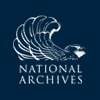Rembrandt Peale to Thomas Jefferson, 8 January 1824
From Rembrandt Peale
Philada Jany 8. 1824.
Dr Sir
The artist who is devoted to his pencil seldom writes with his pen, yet I am induced to take up mine to inform you that my pencil, which of late was employed in the Court of Death, is now performing the mighty act of resuscitating the form of Washington. Although he sat to me for an original Portrait in 1795, and both my father & Stuart painted him in the same year, yet neither of these Portraits ever satisfied me, nor have they satisfied the friends of Washington—Each possesses something good which the others do not, and each has its own peculiar faults. In addition to those materials, we have Houdons bust, which, being made by a mask which was taken from the face of Washington himself, furnishes the exact proportions & the forms of the solid parts, tho’ it be defective in the expression of the soft parts.
My Portrait is a composition from all these, taking my father’s as a base upon which to build—because it is the only one that represents him with his peculiar & Characteristic cast of the head. And I have already advanced so far in it as to satisfy my father that it will surpass everything intended as a representation of Washington. In a few weeks it will be ready to take to the city &, if possible, it is my wish to pay you a visit with it, because if it merit your approbation it not only would afford you some gratification, but your judgment would be of great service in establishing the accuracy of the work which is intended as a National Portrait & standard likeness.
There never was a Portrait undertaken with greater zeal—And this is heightened to the extreme point by the conviction th[. . .] that this great work can be accomplished by no one but myself—as I am the youngest of those to whom Washington sat, & the only one who is not prejudiced in favour of his own portrait. Stuarts portrait is full of dignity & character, but is certainly inaccurate in the drawing & exaggerated—& particularly defective about the mouth, which looks as if it was full of Water. My father’s, tho’ expressive in the general cast of the head & something peculiar about the eyes, is quite unfinished in all the lower part of the face. Mine is more detailed where his is deficient.
The Portrait I am now painting has a grand & imposing aspect & is calculated for public Buildings—But I have designed, to suit the same head, an Equestrian Portrait, with the hope of getting a commission to paint it for the National Hall. This would be particularly flattering to me before I pass to Europe, where I contemplate removing next Summer—indeed nothing but a large commission from the public can delay me. The Arts are not sufficiently encouraged here, whilst London offers everything to stimulate their professors to the greatest exertions. Three times, after visiting Europe, have I tried to be satisfied with the state of things at home—but, commerce engrosses all attention—there is no wealth, leisure nor fancy for the Fine Arts, And I long for a Society in which they are appreciated, employed & rewarded.
I shall be glad to hear that you approve my plan & shall be delighted to find you in good health, And to exhibit before you the result of my efforts
Rembrandt Peale
RC (DLC); edge chipped; addressed: “Thomas Jefferson Monticello”; franked; postmarked Philadelphia, 9 Jan.; endorsed by TJ as received 18 Jan. 1824 and so recorded in SJL.
Peale’s painting, the court of death, based on a poem by Beilby Porteus, is described in Charles Willson Peale to TJ, 3 July 1820, and note.
my portrait: Peale’s Patriæ Pater (1824) was a composite portrait of George Washington based on likenesses by several artists. Referred to as the “Porthole” portrait for its oval-shaped representation of Washington glimpsed through a screen of classical stonework, he subsequently produced at least seventy-five replicas, and the work was also reproduced as a lithograph. The original was purchased in 1832 by the United States Congress and is displayed in the Old Senate Chamber. One of Peale’s prototypes for the work was his own 1795 life portrait of the first president (PHi), reputedly making him the youngest of those to whom washington sat. He also produced an equestrian portrait, Washington before Yorktown (1824), but failed in his efforts to obtain a commission to paint it for the United States Capitol (national hall) (Lillian B. Miller, In Pursuit of Fame: Rembrandt Peale, 1778–1860 [1992], 32–3, 142–6, 174–5).
Index Entries
- Capitol, U.S.; and paintings by R. Peale search
- Congress, U.S.; and paintings for U.S. Capitol search
- Death: A Poetical Essay (B. Porteus) search
- Europe; and encouragement of fine arts search
- Houdon, Jean Antoine; bust of G. Washington search
- paintings; by R. Peale search
- Peale, Charles Willson; and R. Peale’s portraits of G. Washington search
- Peale, Charles Willson; portraits by search
- Peale, Rembrandt; as artist search
- Peale, Rembrandt; letters from search
- Peale, Rembrandt; portraits of G. Washington by search
- Peale, Rembrandt; The Court of Death search
- Porteus, Beilby; Death: A Poetical Essay search
- sculpture; of G. Washington search
- Stuart, Gilbert; portrait of G. Washington by search
- The Court of Death (R. Peale) search
- United States; and encouragement of fine arts search
- Washington, George; portraits of search
- Washington, George; sculpture of search

![University of Virginia Press [link will open in a new window] University of Virginia Press](/lib/media/rotunda-white-on-blue.png)
